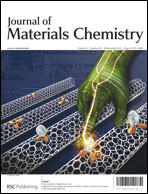The synthesis and the electrochemical, photophysical and photoconductive properties of two new cyclometallated metallomesogens are described. These two complexes were respectively obtained by covalent metallation of Nile red, or a polyalkylated Nile red derivative, to a palladium(II) ion and by using a polyalkylated Schiff base as an ancillary ligand to complete the coordination sphere of the metal centre. The introduction of long alkyl chains on either one or both ligands leads to disk-shaped metallomesogens with ordered room temperature columnar organisation induced, in both cases, by the formation of dimeric pairs. As shown by powder X-Ray diffraction studies, both complexes exhibit a columnar rectangular mesophase over a wide temperature range. These complexes show a redox solution behaviour characterised by one reversible single-electron reduction and two consecutive reversible oxidation waves, which give them an electrochemical amphoteric character. Energy levels and distributions of frontier orbitals have been estimated. Photoconductivity of the mesophase at room temperature has been observed from UV-Vis to near IR wavelength. The high thermal, electrochemical and mesophase stabilities of the studied Nile red complexes confirm that cyclometallated Pd(II) complexes form a new class of photoconductors with features suitable for molecular semiconductor applications.

You have access to this article
 Please wait while we load your content...
Something went wrong. Try again?
Please wait while we load your content...
Something went wrong. Try again?


 Please wait while we load your content...
Please wait while we load your content...